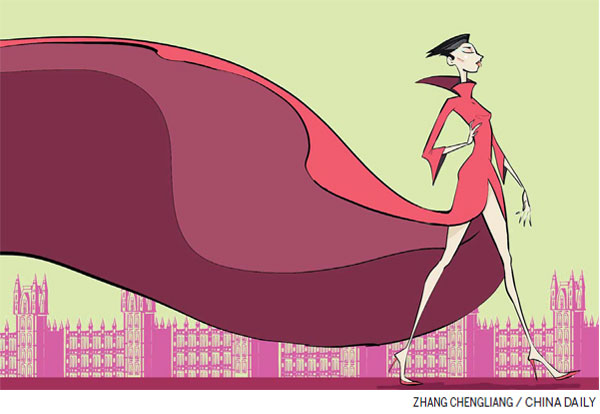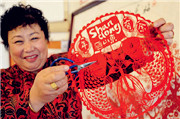Chinese have designs on fashion world
By Mike Bastin ( China Daily Europe )
Updated: 2017-03-19
|
|||||||||
It's clear that their influence - including infusion of their country's heritage - is here to stay
This year's London Fashion Week 2017 again made the fashion front pages around the world but this year Chinese designers made quite a splash and grabbed significant attention.
LFW - one of the "big four" fashion weeks that include New York, Paris and Milan - attracts more than 5,000 attendees each year, and orders of 100 million ($121.7 million; 113.8 million euros) are taken during this window of opportunity and insight into the fashion world.
Before discussing each of the more prominent Chinese designers and their very different approaches and designs, it is important to note that they all share a tremendous appetite for creativity and innovation and all, in some way, play an increasingly significant part in pushing fashion boundaries.

Xander Zhou, the first Chinese menswear fashion designer to display work at London Fashion Week, held last month, continues to stand out and once again received widespread acclaim. Zhou's label is now available not only in London but also New York, Tokyo and Seoul.
While Zhou has become well known for pushing the boundaries between form and function, his compatriot Xiao Li has become internationally renowned for pushing the boundaries between knitwear and silicone. Innovative yarns and textures as well as voluminous shapes, very much Li's trademark, received favorable coverage at LFW.
Li can now boast an enviable list of outlets, including Dover Street Market, H-Lorenzo and 10 Corso Como, and regularly creates four collections a year, covering accessories and footwear in addition to womenswear and menswear.
Not that LFW 2017 has suddenly propelled her into the international spotlight. In 2015, with only three collections to her name, Li was shortlisted for the internationally prestigious LVMH Prize.
Continuing with the boundary-pushing theme, another budding Chinese fashion designer, Xu Zhi, spent a few years under the guidance of J.W Anderson and Craig Green, which appears to have influenced this most innovative and creative young talent. Xu's work was also the subject of widespread media attention at this year's LFW. Unlike Xiao Li, Xu experiments with both yarn and technique but, like Xiao Li, Xu has also received nominations for prestigious fashion industry awards such as the LVMH Prize in 2016.
Xu's work has also been showcased in most of the major fashion capitals, such as Paris and Milan.
Chinese fashion designer success at LFW 2017 will come as no surprise to industry insiders and should soon lead to acknowledgement and acceptance from the fashion consuming public.
Many of these rapidly rising Chinese designers are based in Europe, often London, and the same can be said of Ping He. But what makes Ping He stand out even more is the fact that she has founded her own womenswear label, PINGHE.
Ping launched her eponymous ready-to-wear label in 2012. With LFW exposure year after year, PINGHE has developed into an international luxury brand, with outlets across the US, Europe and Asia.
Not only has Ping helped in no small way to put Chinese designers on the international map, she has contributed to a change in perception around the world about the China brand itself. It is too easy for up-and-coming Chinese fashion designers to hide behind a famous Western label but Ping has not. Instead she has thrust her Chinese name into the international spotlight and continued to build her brand.
Ping was also one of only three designers chosen for the prestigious Swarovski sponsorship to represent the Asia-Pacific in 2016.
Not only are Chinese fashion designers featuring more and more prominently but so also are Chinese fashion designs.
Another shining star of the up-and-coming Chinese fashion design group is Zhang Huishan. Originating in East China's beautiful coastal city of Qingdao, Zhang is following in Ping He's footsteps with a Chinese heritage theme behind many of his designs. Qingdao and the wider Shandong province has a rich heritage that Zhang frequently draws on in what ultimately are often regarded as East-meets-West concepts.
Zhang's work has featured prominently at LFW since 2011 but LFW 2017 marked only the second time that he had staged his own catwalk show at the event, following his first one last year.
At LFW 2017, Zhang's designs were seen to reflect Chinese influences, especially literature and painting. He even introduced seasonality into his collections with colors that aim to infuse his designs with an image of autumn and wintertime in China.
But Zhang does not stop at Chinese heritage, delving into French bohemia, too, in order to continue his East-meets-West theme.
Haizhen Wang, prominent at LFW 2017, can also be added to this growing group of avant-garde, modernist fashion designers who draw on Chinese heritage and art for inspiration. Wang has followed in Ping He's footsteps with his eponymous womenswear label. Widely respected for his dedication to quality as well as creativity, Wang's inspiration appears to draw mainly on Chinese architecture.
Such creativity and fusion of very different cultural influences appears to reflect the overall theme of LFW 2017 and global fashion trends generally at the moment.
Unorthodox color combinations were omnipresent. For example, Johnny Coca at Mulberry displayed a combination of spearmint green boots, worn with a Cadbury purple skirt and ochre shirt. French fashion designer Roland Mouret also attracted attention with a teal, mauve and forest green suede shoe equation.
Turning to fabrics, LFW 2017 was bursting with an abundance of velvet. Light and lithe in appearance, velvet still appears to be very much part of current fashion trends.
LFW 2017 has also highlighted the importance and prominence of nostalgia in many collections. For example, Christopher Kane's satin floral mini dresses would not have looked out of place as the wallpaper of a quintessentially English stately home.
Nostalgia provides an unfathomable depth of heritage for Chinese designers and should continue to feature prominently in their work, now on display across the international fashion landscape.
A fusion of nostalgia and modern influences should combine to set fashion trends for some time to come, with Chinese designers - often foreign-educated and Europe-based - well placed to contribute richly.
The European fashion industry and European fashion consumers, full of admiration for this new breed of Chinese fashion designer, must look closer at what is changing in the fashion world. Not only are Chinese designers becoming more innovative and successful internationally but, crucially, they are infusing their designs with Chinese influences. In order to understand them more fully, the European fashion industry needs to develop its knowledge of Chinese history and all aspects of its culture, such as painting, literature and architecture.
Ancient China, such as the art and literature of the Tang dynasty (618-907), will probably continue to influence this growing number of avant-garde Chinese designers.
LFW 2017 could represent a major turning point in the balance of power in the fashion industry.
It could mark the start of new power-sharing across the fashion world where a tripartite division could soon emerge involving France, Italy and - new kid on the block - China.
Chinese designers have, in many cases for the very first time, carved out a niche on the catwalks of one of the most prestigious biannual fashion shows.
Fashion's future is far from clear but what is clear is that Chinese designer influence and Chinese heritage infusion are here to stay.
The author is a visiting professor at the University of International Business and Economics in Beijing and a senior lecturer at Southampton University.
The views do not necessarily reflect those of China Daily.




